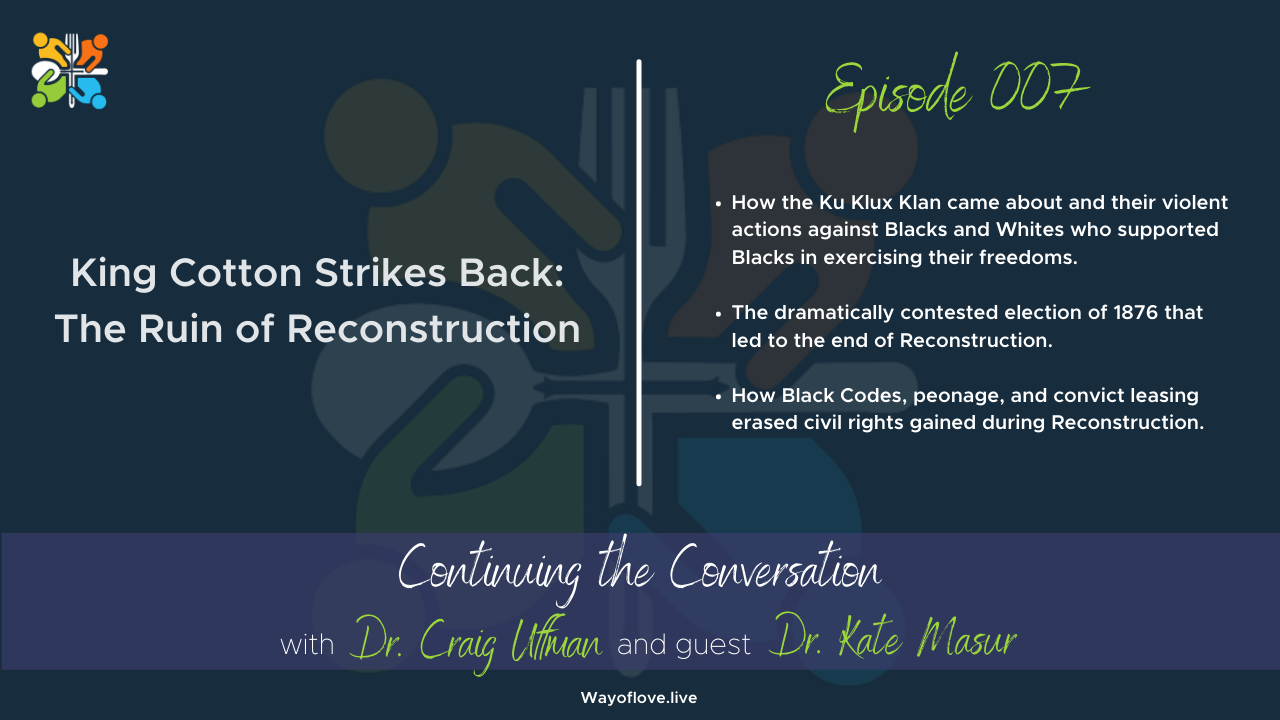“When things like police killings come to light now or injustices and mass incarcerations, for African Americans, it is a story they have known well and for many white folks it is eye-opening that that’s other people’s experiences.” - Dr. Kate Masur
Listen now on Spotify, Apple Podcasts, Google Podcasts, Stitcher and more!

We learned a lot from Dr. Kate Masur about the soaring hopes of Reconstruction after the Civil War and, in particular, constitutional amendments aimed at protecting the basic freedoms of those formerly enslaved. But today, we remember how we fell from the height of these hopes to the darkness of our Jim Crow era.
Dr. Masur is the perfect conversation partner on this topic, and I welcome her back to the Race on the Rocks Podcast today. Dr. Masur is a history professor at Northwestern University. Most of her research investigates how Americans, north and south, grappled with the end of slavery and associated questions of racial equality. Her most recent book is Until Justice Be Done: America’s First Civil Rights Movement, from the Revolution to Reconstruction, which can be pre-ordered now.
Questions for Clergy and Other Group Leaders
- How did the practices of peonage and sharecropping and black codes functioned to limit black economic mobility and ensured cheap labor for the plantation economy after the war?
- What was the original Ku Klux Klan and what did it do?
- Why didn’t Reconstruction work out? Who tried to subvert it, and why/how were they successful?
- How did the Supreme Court play a role in enabling the rise of Jim Crow laws?
- How did the practice of using convict labor in the post-Civil War south serve as a means of repression and intimidation?

Show Notes
- [3:12] - We begin this episode with the groups that sprung up trying to prevent African Americans from executing their newfound rights. Dr. Masur describes the Ku Klux Klan as a vigilante movement opposing the changes happening as a result of the end of slavery.
- [4:33] - Even before black men were given the right to vote, the Ku Klux Klan was formed around 1866.
- [4:51] - The Ku Klux Klan primarily victimized African Americans but also white Republicans, elected officials, and those in interracial relationships.
- [5:30] - They committed various acts of violence and Dr. Masur lists several of the ways they tried to, in their view, put people in their place.
- [6:04] - The image that we have of the Ku Klux Klan in the white robes and pointy hats mostly comes from the Klan of the 1920s and wasn’t popularized until the film A Birth of a Nation in 1915. The Klan of Reconstruction did not have this costume, but still wore disguises.
- [6:42] - The actions of the Ku Klux Klan were illegal and, in 1870 and 1871, the federal government attempted to crack down on them and many were arrested.
- [7:30] - The Grant Administration actually cooled down on this, however, because they were worried about their chance of re-election. This resulted in a resurgence of white supremacy in the south.
- [8:01] - The Ku Klux Klan does not fully encompass this because by 1873 and 1874, other organizations were established and were openly terrorizing people without disguise.
- [9:01] - The election of 1876 took place after the federal refusal to step in and intervene. Much of the end of Reconstruction had already unfolded before that contested election in 1877.
- [9:42] - Dr. Uffman points out that people had “civil rights fatigue” and compares it to the same fatigue and economic recession in the 1970s.
- [10:43] - Dr. Masur also notes the backlash in the 1970s regarding civil rights.
- [11:23] - Shifting back to the late 1800s, Dr. Masur explains that white southerners made the cost of enforcement so high and they were able to get away with more.
- [12:57] - There was a dramatically contested election in 1876 that had everything to do with the issues of Reconstruction. Because of the violence, lawlessness, and terrorism in some southern states, the election was perceived as being very close.
- [13:40] - An election commission was created to settle the election and Hayes, the Republican candidate, was awarded the presidency after months of instability and threats of civil war and violence.
- [15:11] - This landmark election is arguably the end of Reconstruction. Moving forward into the 1880s, Dr. Masur points out the play in the system of coalitions being built between black and white southerners.
- [16:15] - The Supreme Court was very unhelpful to foreseeing the new constitutional amendments. The court interpreted the amendments very narrowly.
- [17:12] - Dr. Masur and Dr. Uffman discuss the Enforcement Act, the Cruikshank Decision, and the growing problem of private violence. The Supreme Court put the responsibility on state governments and in some southern states, specifically Louisiana, the state government supported the Ku Klux Klan.
- [18:34] - By the end of the 19th century, states were writing new constitutions with poll taxes and clauses that were designed to disenfranchise primarily African Americans, but they did not use racial language.
- [21:38] - Convict leasing rose as a way to maintain a business’s supply of labor. Dr. Uffman points out that law enforcement officers were even paid more to arrest more individuals and typically they were people of color.
- [22:59] - Dr. Masur explains that authorities used laws to criminalize the behavior of poor people across the board but especially targeted African Americans. It was very easy to get arrested.
- [23:58] - There was an over-incarceration of African Americans who were then leased out to private corporations and private businessmen. The convicts would provide labor and the businessmen would pay the prison per laborer which was less than hiring a worker.
- [24:38] - Dr. Masur describes the similarities between the system of convict leasing and slavery and the working conditions African Americans were subjected to.
- [26:09] - As a white male from the south, Dr. Uffman shares his experience of getting his driver’s license. Through this discussion with Dr. Masur, Dr. Uffman better understands the difference between his experiences and those of people of color.
- [27:39] - Dr. Masur explains that a white person in trouble with the law would be able to get a lawyer and work themselves out of trouble. But for a black person, they had no reason to believe that justice would be served.
- [28:43] - When things like police killings come to light now or injustices and mass incarcerations, for African Americans, it is a story they have known well and for many white folks it is eye-opening that that’s other people’s experiences.
- [30:07] - One of the grounds of hope during Reconstruction, according to Dr. Masur and others, was the fuse that started people thinking along the lines of making the world a better place.
- [31:42] - A positive change from the Reconstruction era is the surge of people towards education and the education of African Americans.
- [33:03] - In our next episode, we will begin our conversation on the early 20th century with our guest, Dr. Kevin Boyle.
Links and Resources
Connect with Dr. Craig Uffman:
More from Dr. Kate Masur:
- About Kate Masur - Northwestern University
- Kate Masur on Twitter
- Until Justice Be Done: America’s First Civil Rights Movement From Revolution to Reconstruction by Kate Masur
- More books authored by Kate Masur
- “Yes, Wednesday’s attempted insurrection is who we are” Washington Post article by Kate Masur and Gregory Downs

